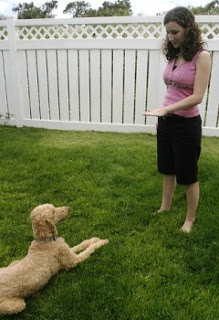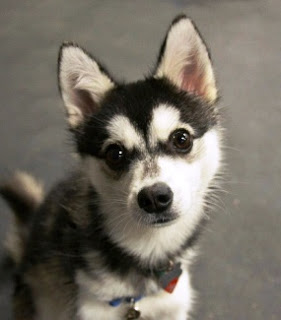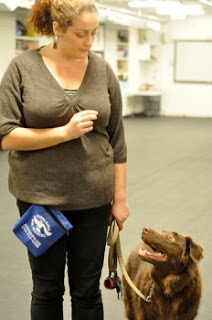Dogs
 By Linda Cole
By Linda Cole
The best teachers are those who first figure out what motivates a child, and then help them learn by communicating clearly. Training your dog is basically the same. If you know your dog and understand his point of view, it's easier to teach him when you’re both on the same page. The following positive dog training tips can help you be more successful.
Positive Feedback
Reward positive behavior and ignore non-aggressive negative behavior. Dogs are quick to learn what works and what doesn't, and when it comes to getting attention, even negative feedback is acceptable, from a dog's point of view. Yelling at your barking dog might stop him for the moment, but it doesn't change his behavior. If you don't want him jumping up on you, don't reward him with attention – ignore him. Teach him what's acceptable with positive attention, and reinforce his behavior with CANIDAE TidNips™ treats and lots of praise. Dogs learn what you teach them, good and bad.
Positive Reinforcement
Remember the high school teacher who gave you positive reinforcement and helped you work through problem areas until you understood? Staying calm, patient and consistent is the respectful way to teach kids and dogs. Yelling and losing your temper isn't cool and tells your dog you need to work on leadership skills. No one, including dogs, likes to be yelled at.
Association
You have less than 2 seconds for your dog to learn to associate an action with a behavior. When training, treat/praise your dog as soon as he completes a command so he learns to connect his action with your command. With a “sit” command, treat/praise the second his butt hits the floor. Dogs live in the now and you can't punish him for what he did hours or even minutes ago. If you catch him in the act, however, you have a chance to change his behavior with positive reinforcement.
Give a Grand Prize
When I started working with my Border Collie mix to teach her to sit, she'd give me a look to see if I really meant what I said. After a few seconds, she'd start to sit, hesitate for a second and then put her bottom on the floor. But if she sat immediately, I gave her lots of treats and abundant praise for a job well done. This is a good tactic to use just before you end a training session. Give your dog a command he is sure to obey right away and reward with multiple treats and praise. If your dog loves a game of catch or tug of war, this would also be a grand prize reward for him – something special to celebrate the achievement.
 Redirect a Behavior
Redirect a Behavior
The sit command is a basic one that comes in handy in many situations. Dogs that jump up on people can be taught to redirect their behavior to a more acceptable one of sitting when they greet someone. A dog that likes to use his paw to get your attention can be taught to give a “high five” on your command instead of pawing at your leg or arm for attention. Redirect negative behavior with a desirable behavior.
Practice Success
When training, give your dog plenty of opportunities to succeed. You aren't giving him a quiz to pass or fail. Don't expect him to learn how to sit and stay for 15 seconds right off the bat. You need to start off slow with shorter time periods. Begin with a few seconds and add a couple seconds at a time until he learns to wait for you to release him. Don't be afraid to go back to the beginning and start again, if necessary. Help him be successful one step at a time, and reward each success.
 Use Food Rewards
Use Food Rewards
Food is a good motivator that can help your pet learn a behavior, but praise is also a powerful incentive. Always give a treat while your pet is learning, along with lots of praise. Eventually, you want to eliminate treats for the most part, but don't stop completely. Every now and then, give treat rewards to let your dog know he's doing a good job. Besides, even dogs like an occasional surprise.
Keep it Short and Fun
Learning is easier when it's short and fun. Sessions should be around 5 minutes, two or three times a day. Work on one behavior at a time. You don't want to confuse your pet by overloading him with multiple behaviors to learn at the same time. Once your dog learns a command or new behavior, practice it daily to reinforce it.
Top photo by Molly Hayden
Middle and bottom photos by Andrea Arden
Read more articles by Linda Cole
- Five Reasons Why Your Dog Ignores You
By Linda Cole There's no getting around it, some dogs are quite good at ignoring their owner! It's frustrating when you try to get your dog's attention and he keeps on doing whatever it is he's doing. Here are five reasons why your dog...
- How To Teach Your Cat To Come On Command
By Linda Cole Because cats are perceived as independent or aloof, many people don't try to teach their cat to come when called. I'm sure from the cat's point of view, she justifies her refusal to come on command with “Does the Queen come...
- How To Use A Clicker To Train Your Dog Or Cat
By Linda Cole Clicker training has been rising in popularity over the last several years as a useful tool for dog training. Many professional dog trainers never leave home without their clicker and use it in conjunction with treats and positive reinforcement....
- Positive Reinforcement: The Power Of Praise
By Linda Cole Dogs and cats are social creatures, and they respond to positive and negative interaction with us. Some days it seems like the only thing I say to my pets is no or stay down. It's easy to see things they do wrong and correct them for...
- 10 Tips On How To Teach Your Dog Good Behavior
How can you teach a dog good behavior? Here are ten tips: 1. Use positive reinforcement. When a dog isn’t behaving well, don’t yell or say NO! Instead, reinforce a positive action such as “Sit” or “Stay”. Help your dog to understand...
Dogs
8 Positive Dog Training Tips That Work

The best teachers are those who first figure out what motivates a child, and then help them learn by communicating clearly. Training your dog is basically the same. If you know your dog and understand his point of view, it's easier to teach him when you’re both on the same page. The following positive dog training tips can help you be more successful.
Positive Feedback
Reward positive behavior and ignore non-aggressive negative behavior. Dogs are quick to learn what works and what doesn't, and when it comes to getting attention, even negative feedback is acceptable, from a dog's point of view. Yelling at your barking dog might stop him for the moment, but it doesn't change his behavior. If you don't want him jumping up on you, don't reward him with attention – ignore him. Teach him what's acceptable with positive attention, and reinforce his behavior with CANIDAE TidNips™ treats and lots of praise. Dogs learn what you teach them, good and bad.
Positive Reinforcement
Remember the high school teacher who gave you positive reinforcement and helped you work through problem areas until you understood? Staying calm, patient and consistent is the respectful way to teach kids and dogs. Yelling and losing your temper isn't cool and tells your dog you need to work on leadership skills. No one, including dogs, likes to be yelled at.
Association
You have less than 2 seconds for your dog to learn to associate an action with a behavior. When training, treat/praise your dog as soon as he completes a command so he learns to connect his action with your command. With a “sit” command, treat/praise the second his butt hits the floor. Dogs live in the now and you can't punish him for what he did hours or even minutes ago. If you catch him in the act, however, you have a chance to change his behavior with positive reinforcement.
Give a Grand Prize
When I started working with my Border Collie mix to teach her to sit, she'd give me a look to see if I really meant what I said. After a few seconds, she'd start to sit, hesitate for a second and then put her bottom on the floor. But if she sat immediately, I gave her lots of treats and abundant praise for a job well done. This is a good tactic to use just before you end a training session. Give your dog a command he is sure to obey right away and reward with multiple treats and praise. If your dog loves a game of catch or tug of war, this would also be a grand prize reward for him – something special to celebrate the achievement.
 Redirect a Behavior
Redirect a BehaviorThe sit command is a basic one that comes in handy in many situations. Dogs that jump up on people can be taught to redirect their behavior to a more acceptable one of sitting when they greet someone. A dog that likes to use his paw to get your attention can be taught to give a “high five” on your command instead of pawing at your leg or arm for attention. Redirect negative behavior with a desirable behavior.
Practice Success
When training, give your dog plenty of opportunities to succeed. You aren't giving him a quiz to pass or fail. Don't expect him to learn how to sit and stay for 15 seconds right off the bat. You need to start off slow with shorter time periods. Begin with a few seconds and add a couple seconds at a time until he learns to wait for you to release him. Don't be afraid to go back to the beginning and start again, if necessary. Help him be successful one step at a time, and reward each success.
 Use Food Rewards
Use Food RewardsFood is a good motivator that can help your pet learn a behavior, but praise is also a powerful incentive. Always give a treat while your pet is learning, along with lots of praise. Eventually, you want to eliminate treats for the most part, but don't stop completely. Every now and then, give treat rewards to let your dog know he's doing a good job. Besides, even dogs like an occasional surprise.
Keep it Short and Fun
Learning is easier when it's short and fun. Sessions should be around 5 minutes, two or three times a day. Work on one behavior at a time. You don't want to confuse your pet by overloading him with multiple behaviors to learn at the same time. Once your dog learns a command or new behavior, practice it daily to reinforce it.
Top photo by Molly Hayden
Middle and bottom photos by Andrea Arden
Read more articles by Linda Cole
- Five Reasons Why Your Dog Ignores You
By Linda Cole There's no getting around it, some dogs are quite good at ignoring their owner! It's frustrating when you try to get your dog's attention and he keeps on doing whatever it is he's doing. Here are five reasons why your dog...
- How To Teach Your Cat To Come On Command
By Linda Cole Because cats are perceived as independent or aloof, many people don't try to teach their cat to come when called. I'm sure from the cat's point of view, she justifies her refusal to come on command with “Does the Queen come...
- How To Use A Clicker To Train Your Dog Or Cat
By Linda Cole Clicker training has been rising in popularity over the last several years as a useful tool for dog training. Many professional dog trainers never leave home without their clicker and use it in conjunction with treats and positive reinforcement....
- Positive Reinforcement: The Power Of Praise
By Linda Cole Dogs and cats are social creatures, and they respond to positive and negative interaction with us. Some days it seems like the only thing I say to my pets is no or stay down. It's easy to see things they do wrong and correct them for...
- 10 Tips On How To Teach Your Dog Good Behavior
How can you teach a dog good behavior? Here are ten tips: 1. Use positive reinforcement. When a dog isn’t behaving well, don’t yell or say NO! Instead, reinforce a positive action such as “Sit” or “Stay”. Help your dog to understand...
